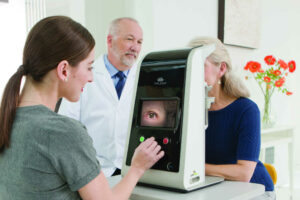Dry age related macula degeneration – Valeda
Case
Someone came into the practice as they were concerned about their parent (Patient X) as they have noticed they have started to have difficulty recognising faces and are struggling to read. We suggested that Patient X booked an appointment with one of our Optometrists.
First appointment
Patient X came in for the appointment and it was found that they suffer with dry AMD (Age related macula degeneration.) This is a common eye disorder among people over 50. It causes blurred or reduced central vision due to the breaking down of the inner layers of the macula, (part of the retina that gives the eye clear vision in the direct line of sight.)
Dry macula degeneration can start in one eye before developing in the other eye, or it can develop in both eyes at the same time.
Over time, vision may worsen which can affect the ability to do things, such as:
- Read.
- Drive.
- Recognise faces.
- Adjusting to a change in light conditions.
Having dry macula degeneration doesn’t mean you’ll lose all your sight. Vision loss is normally central, and people retain their peripheral vision. Some people have only mild central vision loss. In others, it can be more severe. After the appointment, the Optometrist decided that Patient X would be suitable for the Valeda treatment.
Valeda
Valeda is the first approved European treatment for dry macula degeneration. Previously patients were expected to stabilise the condition by lifestyle changes, sunlight protection, supplements, and the cessation of smoking. Now LumiThera have developed the Valeda device which harnesses photobiomodulation for safe and effective treatment of dry AMD.
Valeda uses low-level wavelengths of light therapy to energise and provide oxygen to the retinal cells. The light site 1 study showed an improvement in vision, increased contrast sensitivity and a reduction in retinal metabolic waste (drusens). The other benefit of Valeda is a reduction in inflammation and general slowing of the progression of AMD. LumiThera are currently trialling other uses of photobiomodulation such as for the treatment of diabetic maculopathy.
Treatment
The Valeda treatment involves 9 sessions over a 3-week period (1 block). At the first appointment the patient will see the Optometrist who will take an image of the back of the patient’s eye with the Optomap and a scan using the OCT. The treatment is repeated every 6 months with our Optometrists reviewing and analysing your eye health in between the treatment blocks. The ongoing Valeda treatment is comparable to physiotherapy of the eye. Currently, Valeda is the only equipment approved to specifically target the retina and slow down the progression of AMD. Furthermore, this new treatment is non-invasive, easy, and completely safe.
After Treatment
After 9 sessions Patient X had an appointment with the Optometrist who checks the patients vision, updates the prescription if required, and they will do the OCT Scan and the Optomap image. They will then discuss the treatment and compare them to the scans that were taken on the initial appointment. Patient X is very happy and said they have improved clarity and colours are more vivid.


